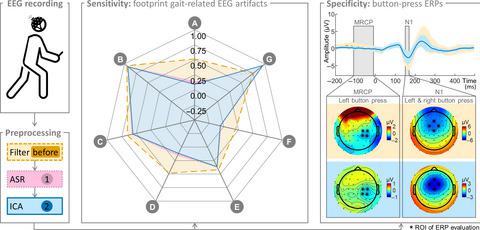当前位置:
X-MOL 学术
›
Eur. J. Neurosci.
›
论文详情
Our official English website, www.x-mol.net, welcomes your feedback! (Note: you will need to create a separate account there.)
A walk in the park? Characterizing gait-related artifacts in mobile EEG recordings
European Journal of Neuroscience ( IF 3.698 ) Pub Date : 2020-09-09 , DOI: 10.1111/ejn.14965 Nadine Svenja Josée Jacobsen 1 , Sarah Blum 1 , Karsten Witt 2 , Stefan Debener 1
European Journal of Neuroscience ( IF 3.698 ) Pub Date : 2020-09-09 , DOI: 10.1111/ejn.14965 Nadine Svenja Josée Jacobsen 1 , Sarah Blum 1 , Karsten Witt 2 , Stefan Debener 1
Affiliation

|
Brain activity during natural walking outdoors can be captured using mobile electroencephalography (EEG). However, EEG recorded during gait is confounded with artifacts from various sources, possibly obstructing the interpretation of brain activity patterns. Currently, there is no consensus on how the amount of artifact present in these recordings should be quantified, or is there a systematic description of gait artifact properties. In the current study, we expand several features into a seven-dimensional footprint of gait-related artifacts, combining features of time, time-frequency, spatial, and source domains. EEG of N = 26 participants was recorded while standing and walking outdoors. Footprints of gait-related artifacts before and after two different artifact attenuation strategies (after artifact subspace reconstruction (ASR) and after subsequent independent component analysis [ICA]) were systematically different. We also evaluated topographies, morphologies, and signal-to-noise ratios (SNR) of button-press event-related potentials (ERP) before and after artifact handling, to confirm gait-artifact reduction specificity. Morphologies and SNR remained unchanged after artifact attenuation, whereas topographies improved in quality. Our results show that the footprint can provide a detailed assessment of gait-related artifacts and can be used to estimate the sensitivity of different artifact reduction strategies. Moreover, the analysis of button-press ERPs demonstrated its specificity, as processing did not only reduce gait-related artifacts but ERPs of interest remained largely unchanged. We conclude that the proposed footprint is well suited to characterize individual differences in gait-related artifact extent. In the future, it could be used to compare and optimize recording setups and processing pipelines comprehensively.
中文翻译:

在公园散步?表征移动 EEG 记录中与步态相关的伪影
可以使用移动脑电图 (EEG) 捕获在户外自然行走期间的大脑活动。然而,在步态过程中记录的 EEG 与来自各种来源的伪影相混淆,可能会妨碍对大脑活动模式的解释。目前,对于如何量化这些记录中存在的伪影数量,或者是否有对步态伪影特性的系统描述,尚无共识。在当前的研究中,我们将几个特征扩展为步态相关工件的七维足迹,结合时间、时频、空间和源域的特征。N的脑电图 = 26 名参与者在户外站立和行走时被记录。在两种不同的伪影衰减策略(伪影子空间重建 (ASR) 之后和随后的独立分量分析 [ICA] 之后)之前和之后,与步态相关的伪影的足迹系统地不同。我们还评估了伪影处理前后按钮按下事件相关电位 (ERP) 的地形、形态和信噪比 (SNR),以确认步态伪影减少的特异性。伪影衰减后,形态和 SNR 保持不变,而拓扑结构的质量有所提高。我们的结果表明,足迹可以提供对步态相关伪影的详细评估,并可用于估计不同伪影减少策略的敏感性。而且,对按键 ERP 的分析证明了它的特异性,因为处理不仅减少了与步态相关的伪影,而且感兴趣的 ERP 基本保持不变。我们得出的结论是,所提出的足迹非常适合表征步态相关伪影程度的个体差异。将来,它可用于全面比较和优化记录设置和处理管道。
更新日期:2020-09-09
中文翻译:

在公园散步?表征移动 EEG 记录中与步态相关的伪影
可以使用移动脑电图 (EEG) 捕获在户外自然行走期间的大脑活动。然而,在步态过程中记录的 EEG 与来自各种来源的伪影相混淆,可能会妨碍对大脑活动模式的解释。目前,对于如何量化这些记录中存在的伪影数量,或者是否有对步态伪影特性的系统描述,尚无共识。在当前的研究中,我们将几个特征扩展为步态相关工件的七维足迹,结合时间、时频、空间和源域的特征。N的脑电图 = 26 名参与者在户外站立和行走时被记录。在两种不同的伪影衰减策略(伪影子空间重建 (ASR) 之后和随后的独立分量分析 [ICA] 之后)之前和之后,与步态相关的伪影的足迹系统地不同。我们还评估了伪影处理前后按钮按下事件相关电位 (ERP) 的地形、形态和信噪比 (SNR),以确认步态伪影减少的特异性。伪影衰减后,形态和 SNR 保持不变,而拓扑结构的质量有所提高。我们的结果表明,足迹可以提供对步态相关伪影的详细评估,并可用于估计不同伪影减少策略的敏感性。而且,对按键 ERP 的分析证明了它的特异性,因为处理不仅减少了与步态相关的伪影,而且感兴趣的 ERP 基本保持不变。我们得出的结论是,所提出的足迹非常适合表征步态相关伪影程度的个体差异。将来,它可用于全面比较和优化记录设置和处理管道。


























 京公网安备 11010802027423号
京公网安备 11010802027423号